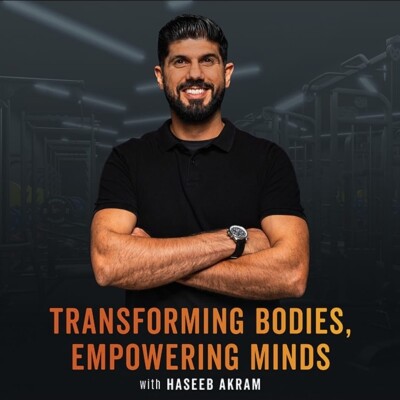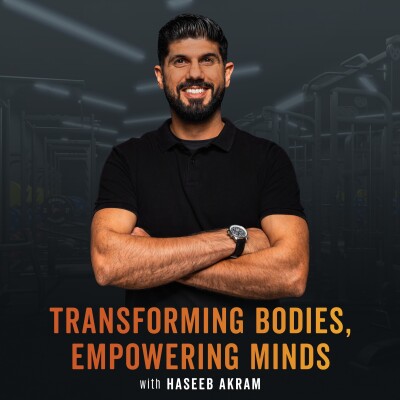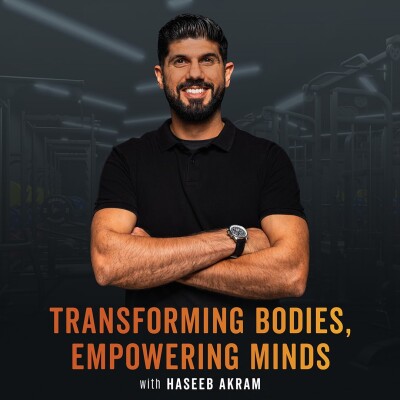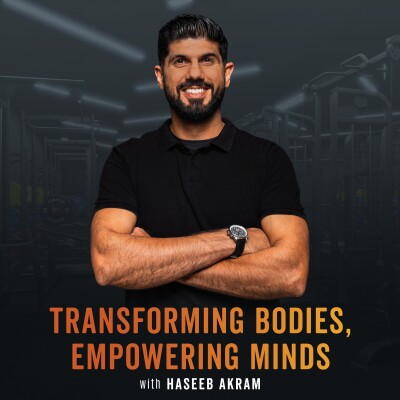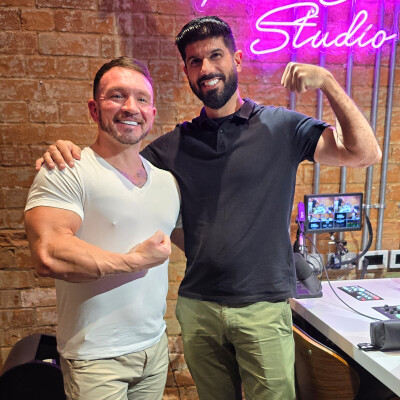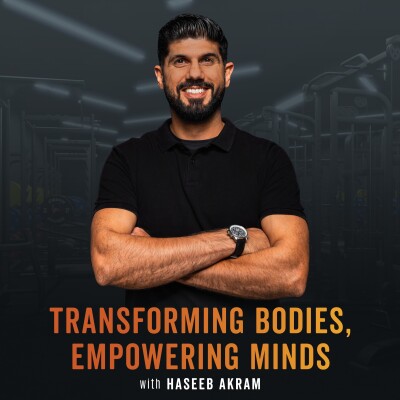Speaker #0Welcome to Transforming Bodies, Empowering Minds. I'm your host, Haseeb Akram, and today we're diving into the world of high-intensity training, otherwise known as HIT. Buckle up, because we're about to embark on a journey that'll transform not just your body, but your entire approach to training. Picture this, you're in the gym, surrounded by people spending hours on end lifting weights, running on treadmills, and generally looking exhausted. Now imagine if I told you there's a way to achieve this. better results in less time. Sounds too good to be true, right? Well, that's exactly what high-intensity training promises. High-intensity training isn't just another fitness fad, it's a scientifically backed approach that's been gaining traction among fitness enthusiasts and researchers alike. Today, we're going to explore what high-intensity training is, why it's so effective, and how you can incorporate it into your fitness routine. So what is high-intensity training? Well, at its core, it's about quality over quantity. It's the fitness equivalent of work smarter, not harder. But don't be fooled. While you might spend less time in the gym, you'll be working harder than ever during those short bursts of activity. High-intensity training involves performing exercises with a high level of effort, pushing your muscles to the point of momentary muscular failure. It's like asking your muscles to perform an intense challenge. They can't sustain it for long, but they go stronger in the process. The key principles of high-intensity training are, number one, High effort. Each exercise is performed to muscular failure. Number two, controlled movements. Exercises are performed with strict form and controlled speed. Three, brief workouts. Sessions are typically shorter than traditional workouts. And number four, infrequent training. More rest between workouts for recovery and growth. High intensity training is often mistaken for high intensity interval training. It's a common misunderstanding in the fitness community. However, they are distinct methods with different focuses and applications. High intensity training involves performing exercises at high intensity until muscular failure without specific intervals of rest in between sets. It emphasizes strength training through controlled movements and focuses on reaching total muscle exhaustion within each exercise session. The goal is to achieve maximum muscle fiber recruitment and stimulate muscle growth and strength gains. In a typical high intensity training session you might perform one set of each exercise to failure with the entire workout lasting no more than say 20 to 30 minutes. High intensity interval training on the other hand alternates between short bursts of intense activity followed by rest or low intensity periods. It's commonly used for cardiovascular conditioning rather than strength building. High intensity interval training sessions are designed to push your heart rate close to its maximum during intense periods before allowing recovery during rest intervals. A typical high intensity interval training session might involve 30 seconds of all out effort followed by 30 seconds of rest repeated for several rounds. While both methods involve high intensity exercise, their primary goals and physiological effects differ. High intensity training is primarily aimed at muscle hypertrophy and strength gains, while high intensity interval training is more focused on improving cardiovascular fitness and endurance. A study in the Journal of Strength and Conditioning Research compared the effects of high intensity training and high intensity interval training on body composition and found that while both methods were effective for fat loss, high intensity training resulted in greater muscle mass gains. This underscores the different adaptations that occur with each training method. The confusion between these two methods is prevalent because both involve high effort exercises aimed at maximising efficiency in a short time frame. Both also offer benefits in terms of time efficiency and calorie burn. However, their specific applications can vary depending on individual fitness goals. Understanding these differences can help you choose the right approach based on your specific fitness goals. If your primary goal is to build muscle and increase strength, high-intensity training will be the better choice. If you're more focused on improving cardiovascular fitness and endurance, then high-intensity interval training would be more suitable. Of course, a well-rounded fitness program might incorporate elements of both but understanding the distinctions can help you tailor your workouts more effectively. For the remainder of this episode, I'll focus exclusively on high-intensity training, which I'll refer to as HIIT. The science behind HIIT. Now, I know what you're thinking. This sounds too good to be true. Where's the catch? Well, let's dive into the science to see why HIIT is so effective. When you perform an exercise to muscular failure, you're recruiting a maximum number of muscle fibers. This process... known as muscle fibre recruitment, is crucial for muscle growth and strength gains. A study published in the Journal of Applied Physiology found that training to failure resulted in greater muscle fibre activation compared to non-failure training. Well, that kind of makes sense. But it's not just about muscle fibre recruitment. HIT also triggers a cascade of physiological responses that contribute to its effectiveness. One of these is the significant increases in anabolic hormones, particularly growth hormone and testosterone. These hormones play a vital role in muscle growth, fat loss and overall body composition. Research has shown that high intensity resistance training can lead to significant increases in these anabolic hormones. Studies found that HIIT protocols resulted in greater post-exercise growth hormone responses compared to traditional resistance training. The benefits of HIIT extend beyond just muscle growth. It's been shown to have a profound impact on cardiovascular health, metabolic rate, and fat oxidation. Studies have shown that high intensity exercise can significantly increase fat oxidation rates, leading to greater fat loss compared to moderate intensity exercise. This means that not only are you building muscle, but you're also burning fat more efficiently. Furthermore, HIIT has been shown to improve mitochondrial function. Mitochondria, often referred to as the powerhouses of our cells, are responsible for producing energy. Studies show that HIIT can increase mitochondrial content and function leading to improved endurance and overall fitness. This improvement in cellular energy production can translate to increased stamina and performance in various physical activities. Another fascinating aspect of HIIT is its effect on muscle protein synthesis. This is how your body builds new muscle tissue. Research has shown that HIIT can stimulate muscle protein synthesis for up to 24 hours after exercise contributing to muscle growth and repair. This prolonged anabolic state means your body continues to build muscle long after you've left the gym. Lastly, HIT has been shown to have significant effects on insulin sensitivity. Insulin is a crucial hormone that regulates blood sugar levels and plays a role in fat storage and muscle growth. A meta-analysis published in Obesity Reviews found that HIT can significantly improve insulin sensitivity in adults. which is crucial for managing blood sugar levels and preventing type 2 diabetes. This improvement in insulin sensitivity can lead to better nutrition partitioning, meaning your body becomes more efficient at using the food you eat for energy and muscle building rather than storing it as fat. Let's start with the cornerstone of any HIIT program, exercise selection. When it comes to HIIT, we do use isolation exercises that target single muscle groups, but we absolutely love compound movements that work. multiple muscle groups simultaneously. We're talking squats, deadlifts, bench presses and rows. These exercises are the heavy hitters of the fitness world and for good reason. Research has shown that these compound exercises lead to greater hormone responses and overall muscle growth compared to isolation exercises. It's like getting more bang for your buck in terms of muscle activation. Compound exercises are like multitasking efficiently. They engage multiple muscle groups at once allowing you to build strength. and improve overall fitness in less time. Much like accomplishing several tasks with one action. Now, here's where HIIT gets really interesting. Once you've chosen your exercises, you're going to perform each one to failure. That's right, you heard me correctly, failure. This means continuing the exercise until you physically cannot perform another repetition with good form. You might be thinking, that sounds intense, and you'd be right. But there's a method to this madness. failure leads to greater muscle fibre activation and potentially greater strength gains. It's like draining your phone battery down to zero percent except this time it's a sign you've made the most out of it. You're pushing your muscles to their absolute limit forcing them to adapt and grow stronger. When it comes to the weight you're lifting we're aiming for the Goldilocks zone. Not too heavy, not too light, but just right. In HIIT, this typically means using a weight that allows you to perform the correct number of repetitions for each exercise. An appropriate rep range for each body part is effective for both strength and muscle growth. It's heavy enough to challenge you, but not so heavy that you risk injury. Think of it as the sweet spot where muscle growth and strength gains intersect. Now, here's where HIIT really sets itself apart from other training methods. Once you've got your exercise and weight sorted, It's time to slow things down, way down. We're talking about moving slowly and with control, aiming for about two to three seconds on the lifting phase and about four seconds on the lowering phase. The slow controlled movement increases time under tension, which has been shown to enhance muscle growth. It's like doing everything in slow motion, except you're building muscle instead of looking ridiculous. This technique forces your muscles to work harder for longer, maximizing the benefits of each repetition. Between exercises you'll want to take a minute or two to catch your breath. This rest period is crucial. It allows for partial recovery of the energy systems used during the exercise enabling you to maintain a high intensity throughout the workout. You should use this time wisely. Catch your breath, hydrate and maybe contemplate why you thought this was a good idea in the first place but remember this brief respite is what allows you to push hard in your next exercise. One of the most appealing aspects of HIIT is its efficiency. A typical workout should last no more than 20 to 30 minutes. Now that's shorter than an episode of whatever you're currently watching on Netflix but infinitely more productive. Research has shown that shorter more intense workouts can be just as effective if not more so than longer, moderate intensity workouts. So this is great news for those of us with busy schedules. You can get in, work hard and get out, all while knowing that you've given your muscles an optimal workout. Now, here's a crucial point that many people overlook. Recovery. Most hip practitioners recommend two to three workouts per week with at least two days of rest between sessions. This recovery time is not optional. It's... absolutely crucial for muscle repair and growth. Studies have found that a minimum of 48 hours of rest between high intensity workouts is necessary for optimal recovery. Your muscles need time to recover and grow. Consider it a well-earned getaway for your muscles. They've been working hard and now they deserve a break. As with any training method there are some pitfalls to watch out for when implementing HIIT. First not going to true failure. Remember the high intensity part of HIIT is crucial. If you're not reaching muscular failure, you're not doing HIIT. Research has shown that training to failure can lead to greater muscle growth and strength gains compared to non-failure training. It's tempting to stop when it gets uncomfortable, but pushing through that discomfort is where the real benefits lie. Training too frequently. More is not always better, especially with HIIT. Overtraining can lead to burnout and injury. Studies have found that training too frequently using HIIT training can lead to decreased performance and increased risk of injury. Listen to your body and give it the rest it needs. Remember, growth happens during recovery, not during the workout. Number three, using momentum. Using momentum. Controlled movements are key in HIIT. Swinging weights around might make you feel like Thor, but it won't give you his muscles. Research has shown that controlled, slower movements lead to greater muscle activation and potentially greater muscle growth. Each rep should be deliberate and controlled, focusing on the muscle you're targeting. Fourth is neglecting proper form. Good form ensures you're targeting the right muscles and avoiding injury. A study in the Journal of Strength and Conditioning Research found that proper form leads to greater muscle activation and reduced risk of injury. It's better to lift lighter weights with perfect form than to sacrifice form for heavier weights. Remember, this is not an ego contest. Fifth, not progressively overloading. As you get stronger, you need to increase the weight or reps. or both to continue challenging your muscles. This principle known as progressive overload is crucial for continued strength and muscle gains. Keep track of your workouts and aim to improve a little each time, whether it's an extra rep or small increase in weight. Remember, training is only part of the equation. Proper nutrition and recovery are crucial for seeing results from HIIT. Ensure you're eating enough protein to support muscle growth and recovery. Good sources of protein include lean meats, fish, eggs, dairy. and plant-based options like legumes and tofu. Aim for about 1.2 to 2 grams of protein per kilogram of body weight per day. Recommended amounts vary depending on the studies, but I found that this range works well for most people. Also, don't neglect carbohydrates and fats. Carbs provide energy for your workouts, while fats are crucial for hormone production. The International Society of Sports Nutrition recommends a balanced diet with 45 to 50 percent of calories from carbs, 15 to 20 percent. protein and around 25 to 35 percent from fats for most athletes. Remember these are general guidelines and may need to be adjusted based on your individual needs and goals. Hydration is also key. Now I know there are many recommendations out there about how much water you should drink but I suggest drinking as much water as you comfortably can throughout the day. On days you work out or active you'll need to drink more than on days you're sedentary. Listen to your body and remember that. proper hydration is crucial for performance and recovery. Finally, don't underestimate the importance of sleep. Aim for at least seven hours a night. There are plenty of studies showing that getting enough sleep is crucial for muscle recovery and growth. When you sleep, your body releases growth hormone and repairs damaged tissue, making it an essential part of your fitness journey. And there you have it, an introduction to high intensity training. We've covered what it is, why it's effective, its benefits. how to implement it and some common mistakes to avoid. Remember, HIIT isn't about spending hours in the gym. It's about making every second count. It's about pushing your limits and challenging your body in new ways. It's about working smarter, not just harder. Before we wrap up today's episode, I want to thank you for joining me on this journey. I'm just getting started, so please show your support by liking, subscribing and sharing it with others who might benefit so you don't miss out on any of the valuable content coming your way. Your support encourages me to create more which in turn I hope will inspire and empower you. Join me for future episodes where we'll dive deeper into specific HIIT techniques, nutrition strategies, success stories and interviews with experts. And if there's a topic you'd like me to cover in an upcoming episode, let me know in the comments. I want to leave you with a thought. fitness isn't just about looking good although that's a nice bonus it's about feeling good being healthy and pushing your limits hit is a tool to help you achieve these goals effectively and efficiently thank you for tuning in to transforming bodies empowering minds and remember the only bad workout is the one that didn't happen so get out there and hit it
